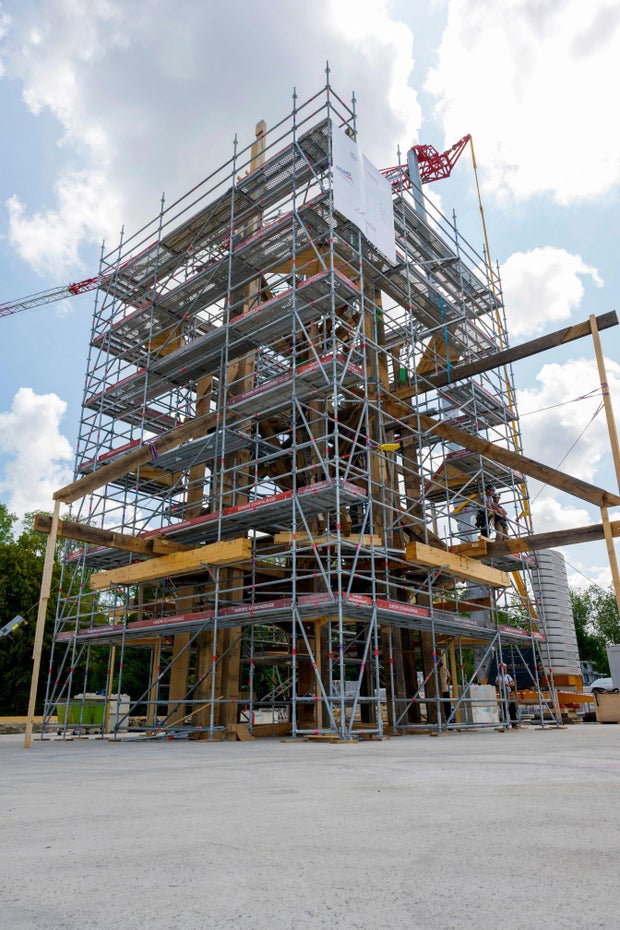Notre Dame cathedral reconstruction project takes a big leap forward
Briey, eastern France – Four years ago, the world looked on in horror as Paris’ Notre Dame cathedral was engulfed in flames. As the fire took hold, the church’s iconic spire, made of oak and metal, was swallowed by the blaze.
Firefighters battled the flames through the night. Astonishingly, most of the church structure survived, but the massive timber roof was lost and the 19th century spire was destroyed.
Soon though, it will be restored to its former glory.
Deep in the French countryside, teams of architects, engineers and artisans have been hard at work. Carpenters measure, cut and chisel centuries-old oak to rebuild the 300-foot spire to its original design, combining methods of the past with tools of today.
Outside the workshops in Briey, in eastern France, they held a dress rehearsal on July 20 to ensure all the carefully-carved components of the spire shaft fit together.
JEAN-CHRISTOPHE VERHAEGEN/AFP via Getty Images
As a crane lowered the final piece of the puzzle onto the 60-foot shaft, there was a sigh of relief from the man in charge of the project, French Army Gen. Jean-Louis Georgelin.
“It’s a very emotional time, because the reconstruction of the spire is the key time phase of the reconstruction of the cathedral,” he told CBS News.
The teams working on the reconstruction of the spire used the original 19th century plans by architect Eugene Viollet-le-Duc. But they relied on modern computers to run 1,600 hours of calculations to figure out just how it was built, and the potential effects
of weather and time on the new structure. After drawing up 320 different versions for the new spire, they were finally ready to
build one.
“It will be exactly the same as it was by Viollet-le-Duc,” said Georgelin. “But we do that with the means of our time: We use computers… We have probably less genius, but more calculation, more certainty by using computers.”
The timber for the spire came from public and private woodlands across France, including some that once belonged to the king and the Catholic church. Only the tallest, straightest oak trees – all of them at least 100 years old – were chosen.
To form the shaft, 285 pieces of that wood were assembled in complex patterns. The architects call the shaft “the heart of the spire.”
Veronique de Viguerie / Getty Images
Architect Axelle Ponsonnet has been working on the reconstruction for two years and admits it has been “very exciting” to work on such a prestigious project.
“It’s not only the famous part of it,” she told CBS News. “Of course, I’m extremely proud to be part of this team and to rebuild Notre Dame. But it’s also a very interesting project, because it’s a very complex structure and today we are never building such structures, and what’s amazing is that we are really trying to be very specific in the way we rebuild it.”
Her colleague and fellow architect Aurélie Ouzineb agreed, calling the project “very complex” and the spire’s original designers and builders “really geniuses.”
She, too, feels privileged to be working on the reconstruction: “It’s very exciting because for us, it’s our job, our everyday job, but we all know that this is a very historical moment.”
Also thrilled to be part of the project is carpenter Benoit Angheben. He came from Belgium to Paris looking for work – and found himself part of the most prestigious reconstruction project of the century.
“It was like a dream,” he said. “I couldn’t believe it – because when it burned, we were all very sad.”
The shaft of the spire is now complete, and it will be taken to Paris in August to be placed on the roof of the cathedral. Work on the rest of the spire continues and it will follow, piece by piece, until the end of this year, when it’s expected to soar once again up into the Paris skyline.
French President Emmanuel Macron promised that Notre Dame would reopen to the public in 2024, and Gen. Georgelin is confident they’ll make the deadline.
“I do my best,” he said. “Every minute in my life is dedicated to that.”
For all the latest Automobiles News Click Here
For the latest news and updates, follow us on Google News.



